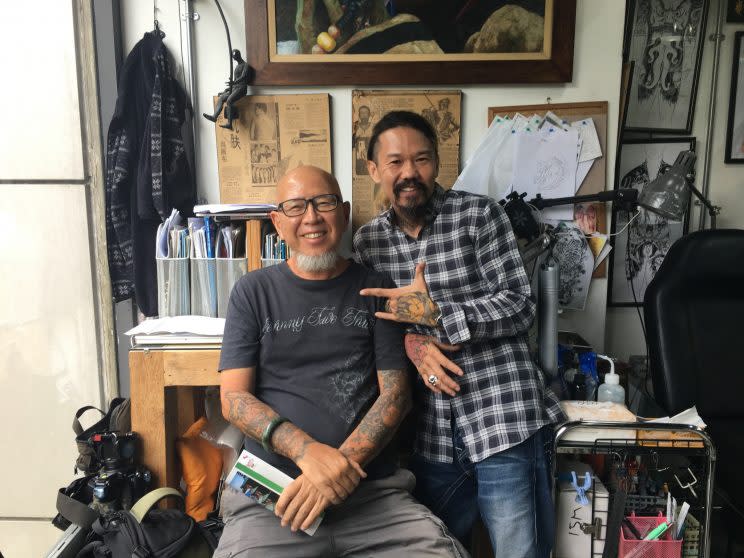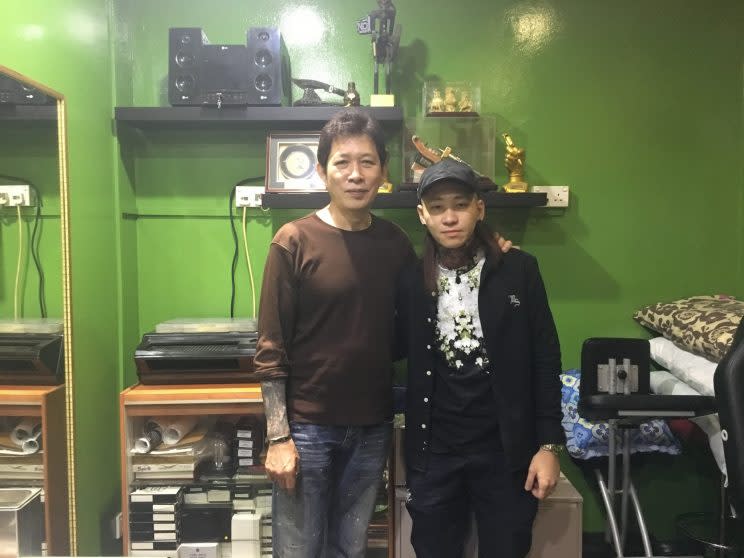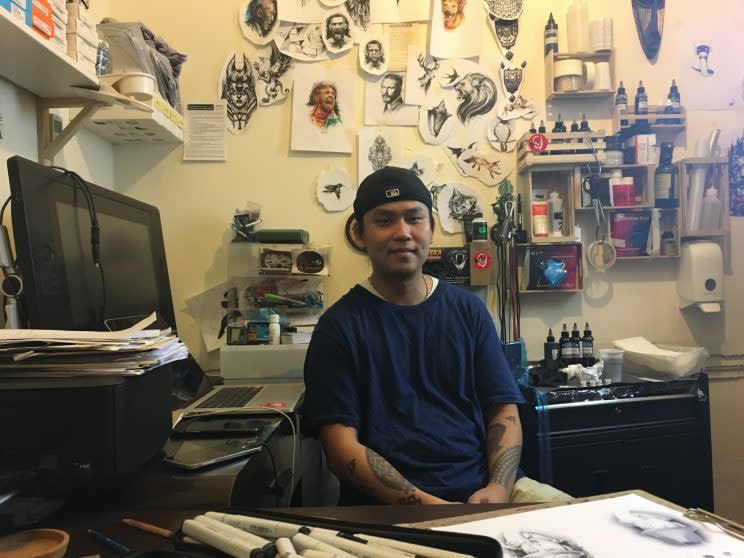Singapore Inked: Tattoo industry here has moved past its secret society heyday

While many in Singapore still associate tattoos with gangsters, it seems that the nation’s body ink industry has moved way past its secret society heyday.
The practice of tattooing began here sometime before World War II. It was common among British and ANZAC soldiers who had their ships docked at Singapore Naval Base during the war, and caught on among gang members decades later, according to pioneer tattoo artist Chak Chow, 62, who has been running the Johnny Two Thumbs Tattoo Studio at Far East Plaza since the late 80s.
The studio is named after one of Singapore’s first tattoo artists, the late Indra Bahadur, whose nickname was “Johnny Two Thumbs”.
In the 90s, Chow observed that the trend had spread to fans of popular celebrities who sported tattoos.
The local tattoo culture has experienced a new wave of change over the decade as more art school graduates and graphic designers have taken up tattooing – a shift that has given birth to new and more creative tattoo styles ranging from realism and portraiture to black out and geometry.
“Last time, people have tattoos because they want to look fierce. But now not so much,” said Chow’s 44-year-old business partner Joshua Ong.
When gang tattoos were popular
Chow was 30 years old when he started his career at Johnny’s studio, which was then called New Lucky Store and was located along Bras Basah Road, where Hotel Rendezvous now stands. Johnny was known to have many customers who were British soldiers and members from secret societies.
“Sometime before the Second World War, I remember hearing that tattoos were done by the roadside. It was much later on when they were done in shops. One of the first tattoo artists in Singapore was known as Johnny Two Thumbs. He tattooed many British and ANZAC soldiers and so-called secret societies,” Chow told Yahoo Lifestyle Singapore.
Johnny was a Nepal native and was also running an engraving business under the same roof.
According to Chow, Johnny got part of his nickname from tattooing many British soldiers, whom he would call “Johnny”. The “Two Thumbs” came from the fact that he had an extra thumb on one of his hands. Johnny died in 1988.

“He would paste (sheets of) tattoo designs on the walls for the sailors or soldiers to choose from,” said Chow. When asked about the different types of gang tattoos he had seen in the past, Chow said, “Not much, about three or four sheets.”
After Johnny’s death, the authorities acquired the land where New Lucky Store stood. Chow, together with his business partner Richard – Johnny’s son – moved to Far East Plaza and renamed the business Johnny Two Thumb Tattoo Studio.
Another pioneer tattoo artist, 58-year-old William Yeo, recalled a time when gang tattoos were popular.
“When I was young I saw a lot of these (gang tattoos)… Last time, if the police saw you with a gang tattoo, they would take your ICs and ask you to cover it black,” said the self-taught artist, who has been running William Tattoo Studio at Golden Mile Tower since 1998.
He also recalled seeing at least 10 different gang logo tattoos in the past, which were typically placed on one’s fingers or forearms.

Protecting the local trade
According to Ong, who has been a tattoo artist for 19 years, there were very few tattoo studios in Singapore when they first opened at Far East Plaza.
“From what I know, there were only three places in Singapore with tattoo studios at that time. It was here, Peninsula and Yishun,” said Ong, who is also known as “JAWS”.
In the past, tattoo studios in Singapore had built-in cubicles to make sure tattooing was done behind closed doors. Present-day tattoo studios are typically designed with an open concept to encourage a more communal and safe environment for customers.
“They kind of safeguard their rice bowls back then. If you wanted to learn tattoo, nobody would want to teach you. That was a challenge for me, that’s why I had to pick it up myself. Buy my own starter kit,” said Joseph Siow, 39, owner of the Visual Orgasm tattoo studio at Haji Lane.
Siow, who has been tattooing for 18 years, made the career switch from graphic designer to full-time tattoo artist in 2005, the same year he opened his studio. He added, “For me, I like to keep (the studio) open so it’s more like a community space.”
According to Ong, “People have become less conscious about protecting the trade now.”

Touching stories behind the ink
Tattoo artist Aelvin Lim, 36, who is popular in Singapore for his realism and portrait tattoo designs recounted a time when a client wanted an image of her son tattooed on her arm following the five-year-old’s tragic death.
“I remember this case where a lady came in to do a portrait of her son. Her son’s head was crushed in front of her by a bus. She was still holding on to her son. It was in the news,” said Lim, who runs the Imagine tattoo studio at Pearl’s Hill Terrace.
Since each tattoo session typically takes up several hours, he said tattoo artists tend to double up as “counsellors” for their customers, who would open up about their life stories related to the design they had chosen.
“It was quite a heavy moment for me. I felt like it was such a painful loss. But I also felt like I’ve done a certain closure for her,” Lim said about the incident, which took place in 2001. His client shared her story during the five-hour tattoo session.

Kirby Lian, owner of Utopia Tattoo Studio at Roxy Square, remembered a time when he tattooed a 70-year-old customer.
“The client had always wanted a tattoo. His father used to be a sailor and had a tattoo. When the father passed away, he wanted a tattoo to remind him of his father. Unfortunately, his wife wasn’t happy with it.
“Later on, when he had children, they didn’t want him to have a tattoo. Now that he’s in his 70s, he finally got one,” said Lian, who ended up tattooing the client for free.
“It was a small tattoo so it didn’t matter to me,” he added.
Lian was also one of the organisers behind Singapore’s first tattoo convention – called the Singapore Tattoo Show – in 2009. He has been invited to be a judge at the upcoming Singapore Ink Show, which is taking place from 21 to 23 April at the Suntec Convention Centre.
Best time for tattoos
While it’s clear that Singapore’s tattoo industry is moving on from its secret society-linked past, it is also booming – all thanks to the Internet, especially social media, and popular reality shows such as “Miami Ink”.
“Now is the best time to be a tattoo artist in Singapore. Everything is easy these days. In 1998, when I wanted to get a tattoo machine, I didn’t know where to go.
“My time, we don’t know much about computers also. (Eventually), I had to order from the US and wait about a week for the goods to arrive in Singapore. Now there are so many suppliers. Even Singapore has its own supplier called Asia Tattoo Supply,” said Yeo.
He added, “Tattoo machines these days are not heavy. Before me… the machines are so big and they would use car batteries to power them. Now you just need a regular power plug. Very convenient.”
When we asked tattoo artist of 10 years, Rain Wu, on his thoughts about the stigma of being tattooed in Singapore, especially in the corporate world, he said, “I think for some of these companies, their bosses come from the older generation. Their upbringing is linked to a time when tattoos were directly linked to gangsters.
“But nowadays for young companies and entrepreneurs, they’re more accepting. I would give it another 10 to 20 years. ”
Follow Yahoo Lifestyle Singapore on Facebook.



